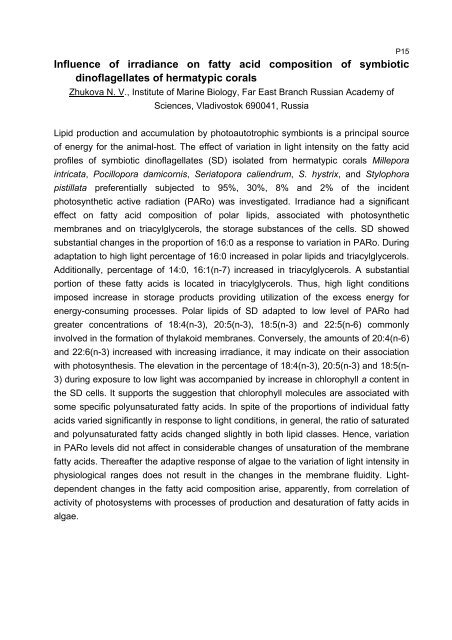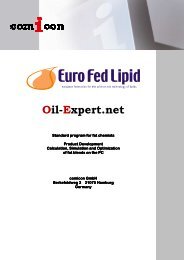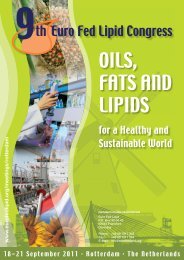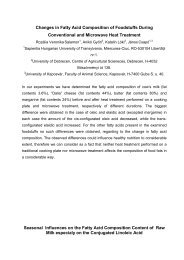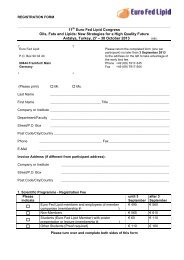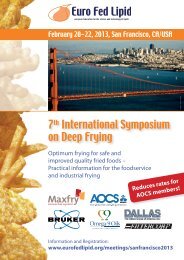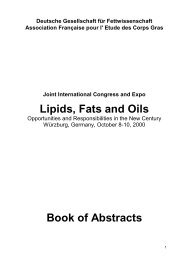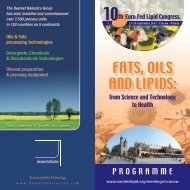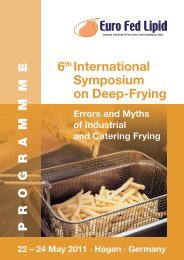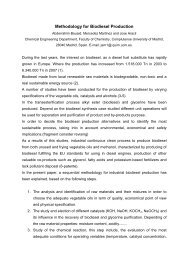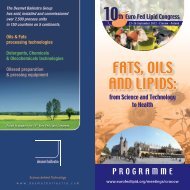Abstracts now available online - Euro Fed Lipid
Abstracts now available online - Euro Fed Lipid
Abstracts now available online - Euro Fed Lipid
You also want an ePaper? Increase the reach of your titles
YUMPU automatically turns print PDFs into web optimized ePapers that Google loves.
P15<br />
Influence of irradiance on fatty acid composition of symbiotic<br />
dinoflagellates of hermatypic corals<br />
Zhukova N. V., Institute of Marine Biology, Far East Branch Russian Academy of<br />
Sciences, Vladivostok 690041, Russia<br />
<strong>Lipid</strong> production and accumulation by photoautotrophic symbionts is a principal source<br />
of energy for the animal-host. The effect of variation in light intensity on the fatty acid<br />
profiles of symbiotic dinoflagellates (SD) isolated from hermatypic corals Millepora<br />
intricata, Pocillopora damicornis, Seriatopora caliendrum, S. hystrix, and Stylophora<br />
pistillata preferentially subjected to 95%, 30%, 8% and 2% of the incident<br />
photosynthetic active radiation (PARo) was investigated. Irradiance had a significant<br />
effect on fatty acid composition of polar lipids, associated with photosynthetic<br />
membranes and on triacylglycerols, the storage substances of the cells. SD showed<br />
substantial changes in the proportion of 16:0 as a response to variation in PARo. During<br />
adaptation to high light percentage of 16:0 increased in polar lipids and triacylglycerols.<br />
Additionally, percentage of 14:0, 16:1(n-7) increased in triacylglycerols. A substantial<br />
portion of these fatty acids is located in triacylglycerols. Thus, high light conditions<br />
imposed increase in storage products providing utilization of the excess energy for<br />
energy-consuming processes. Polar lipids of SD adapted to low level of PARo had<br />
greater concentrations of 18:4(n-3), 20:5(n-3), 18:5(n-3) and 22:5(n-6) commonly<br />
involved in the formation of thylakoid membranes. Conversely, the amounts of 20:4(n-6)<br />
and 22:6(n-3) increased with increasing irradiance, it may indicate on their association<br />
with photosynthesis. The elevation in the percentage of 18:4(n-3), 20:5(n-3) and 18:5(n-<br />
3) during exposure to low light was accompanied by increase in chlorophyll a content in<br />
the SD cells. It supports the suggestion that chlorophyll molecules are associated with<br />
some specific polyunsaturated fatty acids. In spite of the proportions of individual fatty<br />
acids varied significantly in response to light conditions, in general, the ratio of saturated<br />
and polyunsaturated fatty acids changed slightly in both lipid classes. Hence, variation<br />
in PARo levels did not affect in considerable changes of unsaturation of the membrane<br />
fatty acids. Thereafter the adaptive response of algae to the variation of light intensity in<br />
physiological ranges does not result in the changes in the membrane fluidity. Lightdependent<br />
changes in the fatty acid composition arise, apparently, from correlation of<br />
activity of photosystems with processes of production and desaturation of fatty acids in<br />
algae.


